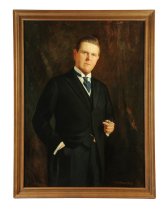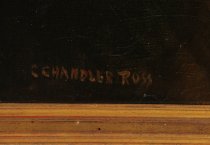Object Record
Images


Metadata
Catalog Number |
1900.001.050 |
Object Name |
Painting |
Collection |
Statehouse Artwork Collection/Governors' Portraits |
Title |
Portrait of A. Victor Donahey |
Artist |
Ross, C. Chandler |
Date |
Unknown |
Description |
Three-quarter length portrait of Ohio's 50th governor, A. Victor Donahey, who served from 1923 to 1929. In this portrait Donahey is elegantly dressed in a dark blue suit with a blue vest, white shirt, and a blue and white polka dot tie. There is a gold chain and watch fob at his waist. He holds a pair of eyeglasses in his proper left hand. |
Material |
Oil Paint/Canvas/Wood |
Notes |
Alvin Victor Donahey was born on July 7, 1873, in West Chester, Ohio. Donahey preferred to be called "Vic." He attended public schools in West Chester and New Philadelphia. Donahey did not graduate from high school, leaving school as a junior to work in a printing office. He quickly rose through the ranks, becoming a foreman in less than three years, and he eventually owned his own printing company in New Philadelphia. While still in his twenties, Donahey embarked upon a political career. He was a member of the Democratic Party, but he resided in a portion of Ohio that was overwhelmingly Republican. Nevertheless, he became a township clerk in 1898, serving two terms. In 1904, Donahey won election as Tuscarawas County's auditor, a position that he held until 1909. In addition to this office, Donahey also was a member of New Philadelphia's Board of Education and was a delegate to the Ohio Constitutional Convention of 1912, serving on the labor, taxation, and initiative and referendum committees. In 1912, Donahey won election to his first statewide office, Ohio auditor. He served eight years, winning reelection in 1916. Under his direction, the auditor's office gained greater control over the state's funds. In 1920, Donahey sought election to the governor's seat, but he was easily defeated by Republican Harry Lyman Davis. In 1922, Davis did not seek reelection, and Donahey won election to the governor's seat by 18,000 votes over Carmi A. Thompson. Ohio voters reelected Donahey in 1924 by 175,000 votes over former governor Davis and again in 1926 by just 16,000 votes over Myers Cooper. As governor, Donahey faced a legislature dominated by Republicans. During his first two terms in office, Donahey vetoed 117 bills, but the legislature eventually passed many of these without the governor's approval. Donahey's use of the veto power earned him the nickname, "veto Vic." Despite the governor's contentious relationship with the legislature, he succeeded in dramatically improving Ohio's roads and reforming the state's judicial system. In 1928, Donahey did not seek reelection. He was in poor health, and he desired to return to his business interests. Donahey, however, was not through with politics. In 1934, he won election to the U.S. Senate over the incumbent, Simeon D. Fess. Donahey served in this office from 1935 to 1941. He died on April 8, 1946. |
Provenance |
In 1867, the Ohio General Assembly passed a joint resolution relative to the governors of Ohio. The legislators resolved that "the secretary of state, on the first Monday of January next, whether the portraits of the governors of Ohio, state and territorial, can be procured, and if so, whether original portraits or copies, and the probable expense of procuring such portraits for the governor's office." Portrait is signed "C. Chandler Ross" in the lower right corner. No written documentation has been located on this portrait. The Capitol Square Review and Advisory Board took over the care of the Statehouse and its collections in 1988. |
Image size |
44" x 32" |
Frame size |
48-1/2" x 36-1/2" |
Frame desc |
Mid-twentieth century gilt molded frame |
People |
Donahey, A. Victor (Alvin Victor), 1873-1946 Ross, C. Chandler |
Search Terms |
Ohio Governor Ohio Governor's Portraits |
Subjects |
Governors Painting Portrait paintings |

